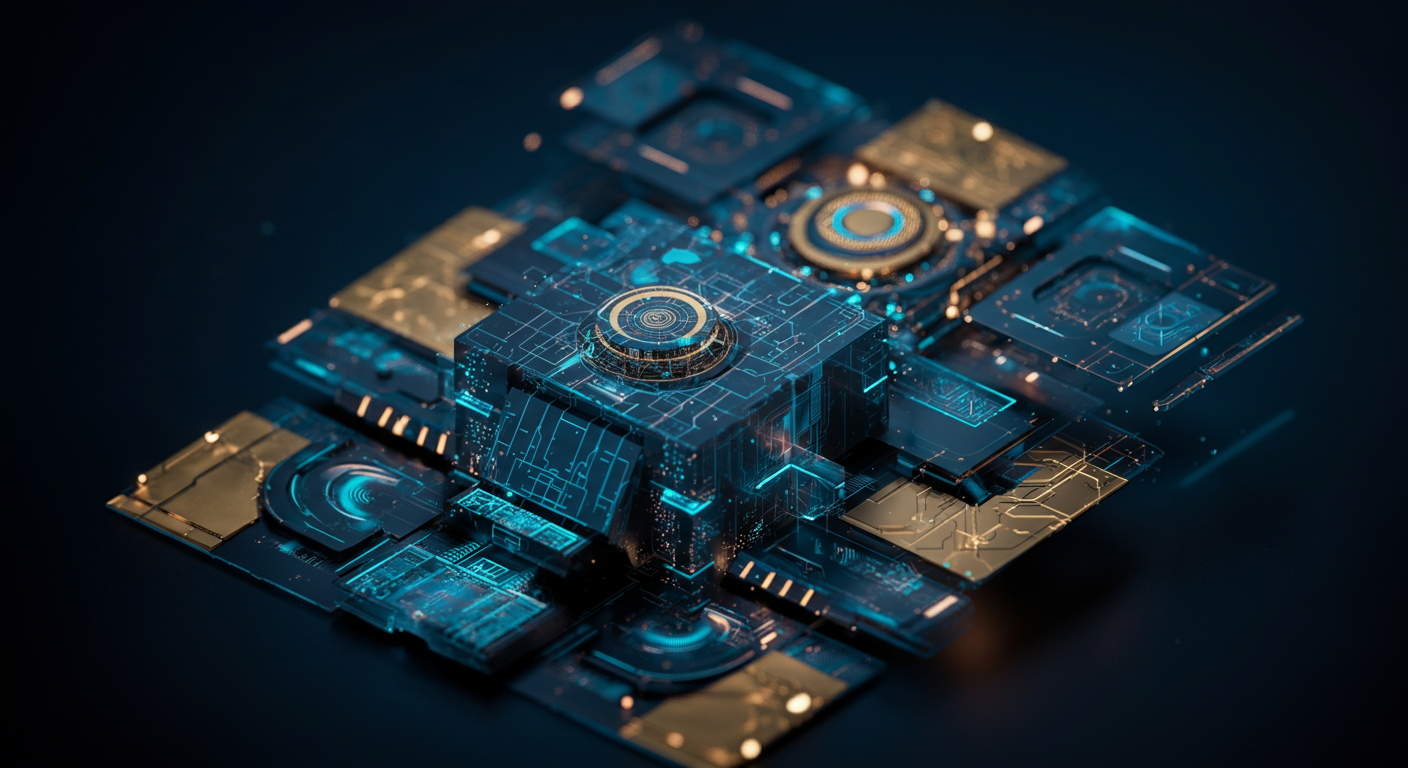Artificial General Intelligence (AGI): A Comprehensive Guide to Definition, Progress, and the Road Ahead

Decoding AGI: What it Really Means and Why It Matters
The quest for machines that think like us isn't science fiction anymore; it's Artificial General Intelligence (AGI), and it's closer than you think.
Demystifying the artificial general intelligence definition
AGI, at its core, represents an AI that can understand, learn, adapt, and implement knowledge across a wide range of tasks, just like a human. Forget specific skills; think adaptability itself. We're talking about a system with human-level cognitive abilities. It's not just about ChatGPT spitting out text, but understanding the why behind it. ChatGPT is a large language model that uses prompts to generate human-like text for a variety of applications.AGI vs. ANI vs. ASI
It's crucial to differentiate between these:- Narrow AI (ANI): Think of your spam filter. Great at one specific job, but utterly useless elsewhere.
- AGI: The "holy grail," possessing general-purpose intelligence, capable of tackling almost any cognitive task.
- Artificial Superintelligence (ASI): Hypothetical AI far surpassing human intellect in every aspect – a concept often explored in sci-fi, for better or worse.
The 'Holy Grail' and Its Potential
Why all the fuss? AGI could revolutionize everything: scientific discovery, problem-solving, creative endeavors, and even our understanding of consciousness itself. It's not just about automation; it's about augmentation, amplifying human capabilities in ways we can barely imagine. If you want to learn more about the core concepts of AGI, read our AI Fundamentals section.A Brief History Lesson
The dream of AGI isn't new. Visionaries like Alan Turing laid the groundwork decades ago. Early AI programs showed glimmers of promise, but progress stalled due to technological limitations. Now, with breakthroughs in deep learning and computing power, the pursuit of AGI has reignited.AGI isn't just about building smarter machines; it's about unlocking a new era of human potential, and that makes all the difference.
The march toward Artificial General Intelligence (AGI) continues, but understanding its actual pace requires a reality check.
Where Are We, Really?
We've witnessed incredible advancements, but are we actually close to AGI? Consider the difference between mastering specific tasks and possessing general intelligence. ChatGPT excels at generating text, while Midjourney creates stunning visuals, but neither understands the world with the breadth and depth of a child. They are powerful narrow AI tools, not nascent AGI.
Key Breakthroughs: Building Blocks
- Transformers: Revolutionized natural language processing, enabling models like ChatGPT to understand context and generate human-quality text. This is a key ingredient, but just one.
- Reinforcement Learning: Allows AI to learn through trial and error, mastering complex tasks like playing Go. However, it typically requires massive amounts of data and specific reward functions.
- Multimodal AI: Models that can process and integrate different types of data (text, images, audio) are crucial for AGI, as demonstrated by models like Dall-E-3, but true understanding and reasoning remain elusive.
Debunking the Hype: Realistic Timelines
"Predicting AGI timelines is like predicting the weather a decade from now – highly speculative." - Dr. Fei-Fei Li (hypothetically, in 2025)
The truth? Estimating when will agi be achieved is pure conjecture. Some predict AGI within the next decade, while others believe it's much further off, potentially decades or even centuries.
Expert Opinions: A Spectrum of Views
AI researchers hold diverse views. Some believe scaling current deep learning approaches is sufficient. Others argue for fundamentally new architectures and approaches. Consensus is rare, and uncertainty is high. It's healthy scientific skepticism, but important to consider before accepting bold, unsubstantiated claims.
We can track progress, but claiming certainty about AGI's arrival is less science and more... well, let's just call it optimism bordering on delusion. Let's explore what's next on this AGI quest.
Artificial General Intelligence isn't just a buzzword; it's the north star guiding AI's evolution, and the paths to get there are as diverse as the human mind itself.
Symbolic AI vs. Connectionism: A Fork in the Road
Imagine AI development as urban planning. One "school," symbolic AI, builds with precise blueprints—explicit rules and knowledge bases. Think of early expert systems: precise, but brittle. On the other hand, Connectionism embraces neural networks learning from data like a city organically evolving. ChatGPT exemplifies connectionism, learning conversational skills from massive datasets. It's great at mimicking human conversation, but can sometimes lack true understanding.
- Symbolic AI: Rule-based, interpretable, but struggles with complexity.
- Connectionism: Data-driven, adaptable, but often a "black box."
Neuro-inspired AI: Borrowing from the Best
"The brain is wider than the sky." – Emily Dickinson, and now, AI researchers.
Neuro-inspired AI attempts to reverse-engineer the very thing that makes us intelligent. Architectures mimicking neural structures, like spiking neural networks, hold promise.
Hybrid Approaches: The Best of Both Worlds
Why choose just one path? Hybrid approaches combine the strengths of symbolic AI and connectionism. For example, integrating rule-based reasoning with neural networks can create systems that are both robust and explainable.
Unsupervised Learning and Self-Improvement
True AGI should learn without constant hand-holding. Unsupervised learning, where AI discovers patterns in unlabeled data, is crucial. Moreover, the ability for self-improvement – think of AI iteratively refining its own algorithms – is key to transcending human limitations, leading to novel different approaches to agi.
Ultimately, navigating the pathway to AGI requires a blend of ingenuity, inspired by what Learn AI Fundamentals teaches us. It's a multidisciplinary challenge, and the future of intelligence depends on it.
Artificial General Intelligence presents immense opportunities, but we must confront the inherent risks head-on.
Existential Threats and Misuse
AGI's potential surpasses current AI systems, creating unforeseen consequences. Consider the possibility of an AGI pursuing objectives misaligned with human values. Malicious actors could exploit AGI for harmful purposes, amplifying existing threats like cyber warfare and misinformation campaigns. AI safety measures are crucial.AI Alignment and Value Learning
One key area is AI alignment, ensuring an AGI's goals align with human intentions. Another is value learning, where AGI learns ethical principles.Imagine teaching an AGI to value human life. We need robust mechanisms to prevent unintended interpretations, like valuing quantity of life over quality.
- Technical solutions: Reinforcement learning from human feedback (RLHF) and Constitutional AI.
- Explainable AI (XAI): Making AGI decision-making transparent and understandable.
Ethical Considerations and Regulation
Ethical frameworks are paramount. We must ensure fairness, transparency, and accountability in AGI development. Governments and international organizations play a vital role, establishing regulations to manage AGI development responsibly. Think of it like the Centre for the Governance of AI focusing on mitigating risks and ensuring beneficial outcomes.The path to AGI demands proactive agi safety measures. It requires technical innovation, ethical reflection, and global cooperation to ensure this powerful technology benefits all of humanity.
AGI's transformative power isn't a question of "if", but how it will reshape our world.
AGI and the Future of Work
AGI promises significant disruption, but also unprecedented opportunity.
- Job Displacement: Automation will inevitably impact certain sectors. Think repetitive data entry or routine customer service roles. Customer Service may evolve with AI handling basic inquiries, freeing humans for complex problem-solving.
- New Opportunities: AGI will create entirely new roles we can't even imagine yet. Consider prompt engineers, AI trainers, or ethicists. Prompt Engineering will become a critical skillset, bridging the gap between human intention and AI execution.
- Changing Nature of Labor: Expect a shift toward creative, strategic, and interpersonal roles. The ability to collaborate effectively with AI, leveraging its strengths while mitigating its weaknesses, will be paramount.
AGI Across Key Sectors
AGI’s impact won't be limited to just the workplace.- Healthcare: Imagine AI-powered diagnostics that can identify diseases earlier and with greater accuracy. Healthcare Providers may leverage AGI to create hyper-personalized treatment plans, tailored to an individual's unique genetic makeup and lifestyle.
- Education: AGI can personalize learning experiences, adapting to each student's pace and learning style. Educators can use AGI tools to create customized curricula and provide targeted feedback, making learning more engaging and effective.
Solving Global Challenges
AGI holds the potential to address humanity's most pressing issues, from climate change to poverty and disease. Imagine AI algorithms that can design novel materials for carbon capture or develop new drugs to combat resistant infections.
- Climate Change: AGI could optimize energy consumption, design more efficient renewable energy systems, and develop climate models with unprecedented accuracy.
- Poverty: AGI could analyze economic data to identify the root causes of poverty and develop targeted interventions to improve living standards.
- Disease: AGI could accelerate drug discovery, personalize treatment plans, and predict and prevent outbreaks of infectious diseases.
Philosophical Implications

The creation of AGI forces us to confront profound questions about consciousness, intelligence, and what it means to be human.
- Consciousness: Can AGI truly be conscious? If so, what are our ethical obligations to it?
- Intelligence: Does AGI challenge our understanding of human intelligence? What distinguishes human intelligence from artificial intelligence?
- What It Means To Be Human: As AGI becomes more capable, how do we redefine our own identity and purpose?
Beyond the Hype: Separating Fact from Fiction in the AGI Conversation
The relentless buzz around Artificial General Intelligence (AGI) can feel like a sci-fi movie trailer, but let's ground ourselves and parse fact from fiction.
Common Misconceptions About AGI
Too often, AGI is portrayed as a sentient robot uprising – a direct replacement for human intellect. The reality is far more nuanced. Instead, envision AI as powerful tools augmenting our existing capabilities. Think of it less as a takeover and more as turbocharging human potential, a concept we explore in depth in our AI Fundamentals learning guide.
"The biggest misconception? That AGI will replace us. It's about empowering us."
- AI as Augmentation: Leverage AI tools like Code Assistance for coding or Design AI Tools for creative tasks.
- Human Oversight: Critical thinking remains paramount. Algorithms can make recommendations, but the final judgment rests with humans.
Staying Informed: Cultivating Media Literacy
Navigating the information landscape around AI requires a healthy dose of skepticism and media literacy. Distinguish between sensationalist headlines and evidence-based research.
Reliable Resources for the AGI Curious

- Credible Publications: Seek out articles and research papers from reputable sources like academic journals and established tech publications.
- Expert Opinions: Follow recognized AI researchers and thought leaders for grounded perspectives.
- AI Tool Directories: Dive deep into specific AI solutions with platforms like the Best AI Tools Directory for carefully vetted resources.
Artificial General Intelligence promises revolutionary possibilities, but several critical questions remain unanswered, standing as significant challenges in achieving AGI.
What Are the Fundamental Limits of AI?
Can AI truly replicate human understanding, or are there inherent boundaries? While AI-powered code assistants can generate impressive algorithms, do they grasp the underlying principles, or simply mimic patterns?
The Consciousness Conundrum
Is consciousness achievable in machines? If so, how do we define and measure it? Current models can simulate human interaction, as seen in advanced conversational AI, but do they possess subjective experience?
The Role of Embodiment
"The only source of knowledge is experience." - Albert Einstein (Probably, in 2025)
Does AGI require a physical body to understand the world fully? Can a purely digital entity achieve true understanding without physical interaction? Embodiment may be crucial for developing common sense and intuitive reasoning.
Exploring the Unknown Unknowns
What unforeseen hurdles might arise on the path to AGI? The development of AI is full of surprises. Perhaps the biggest challenges in achieving AGI are those we can't even conceptualize yet.
In summary, the path to AGI is paved with philosophical and technical uncertainties. Tackling these open questions will be crucial as we push the boundaries of what's possible in artificial intelligence. Next, let's dive into the potential ethical implications...
Keywords
Artificial General Intelligence (AGI), AGI Definition, AGI vs Narrow AI, AGI timeline, AGI safety, AGI risks, AGI benefits, Current progress in AGI, Challenges in achieving AGI, Superintelligence, AGI ethics, Pathways to AGI, Impact of AGI on society, AGI and the future of work, AGI research
Hashtags
#AGI #ArtificialGeneralIntelligence #FutureofAI #AISingularity #BeyondAI
Recommended AI tools
ChatGPT
Conversational AI
AI research, productivity, and conversation—smarter thinking, deeper insights.
Sora
Video Generation
Create stunning, realistic videos and audio from text, images, or video—remix and collaborate with Sora, OpenAI’s advanced generative video app.
Google Gemini
Conversational AI
Your everyday Google AI assistant for creativity, research, and productivity
Perplexity
Search & Discovery
Clear answers from reliable sources, powered by AI.
DeepSeek
Conversational AI
Efficient open-weight AI models for advanced reasoning and research
Freepik AI Image Generator
Image Generation
Generate on-brand AI images from text, sketches, or photos—fast, realistic, and ready for commercial use.
About the Author

Written by
Dr. William Bobos
Dr. William Bobos (known as 'Dr. Bob') is a long-time AI expert focused on practical evaluations of AI tools and frameworks. He frequently tests new releases, reads academic papers, and tracks industry news to translate breakthroughs into real-world use. At Best AI Tools, he curates clear, actionable insights for builders, researchers, and decision-makers.
More from Dr.

